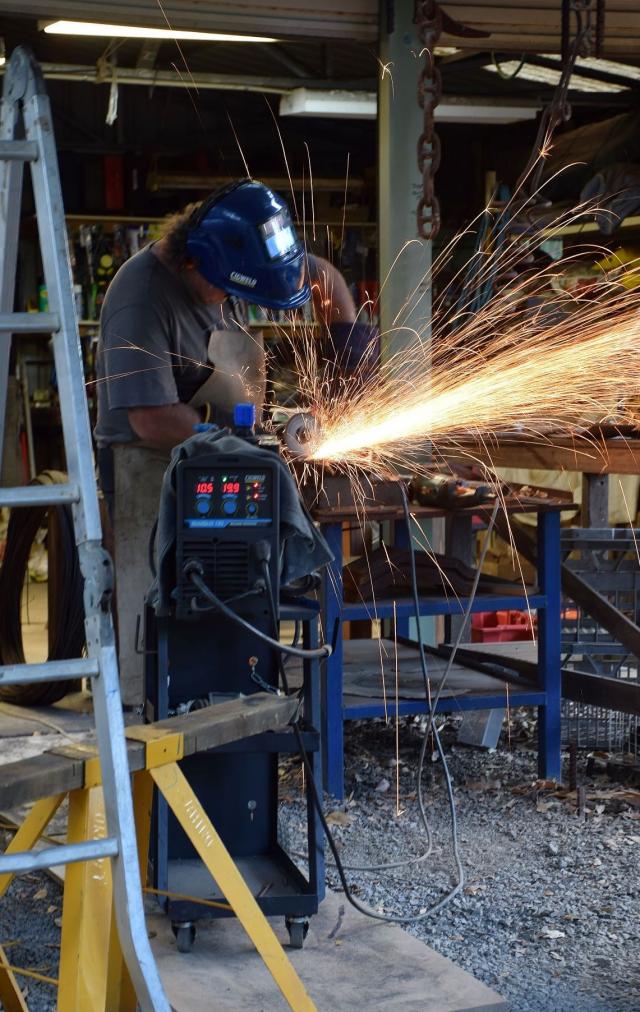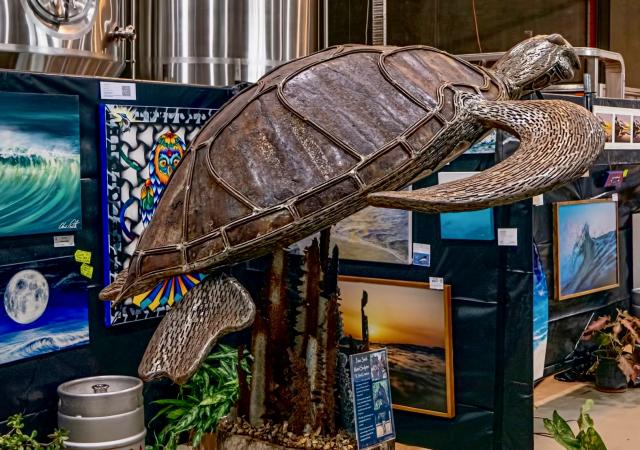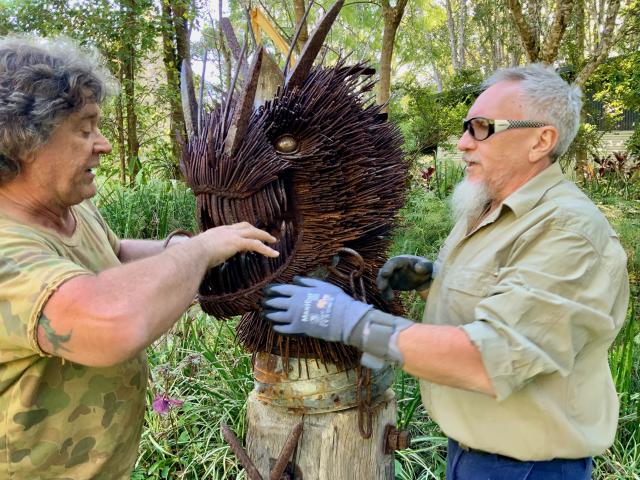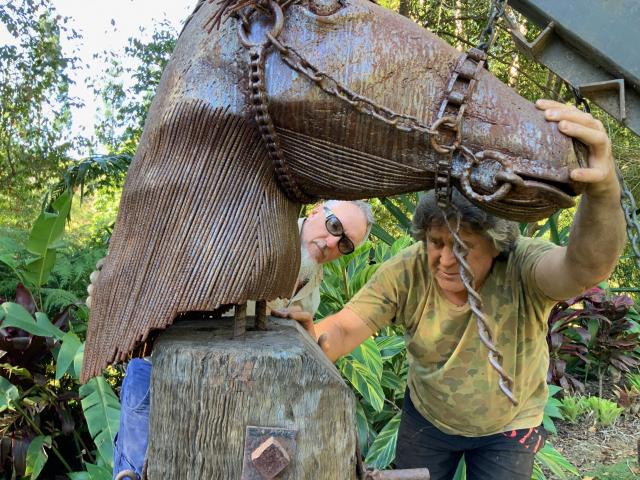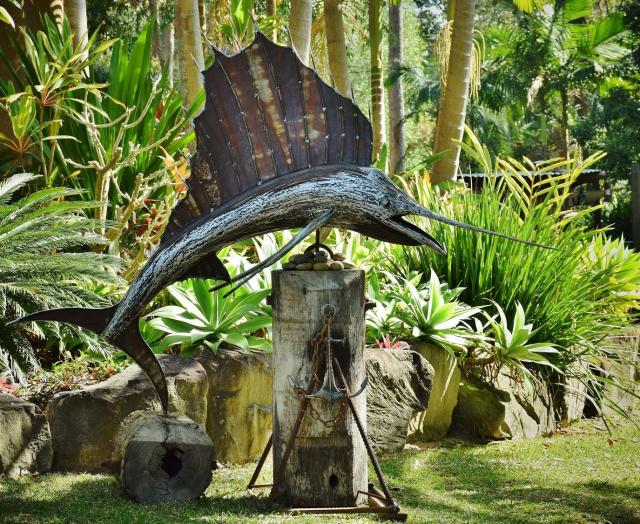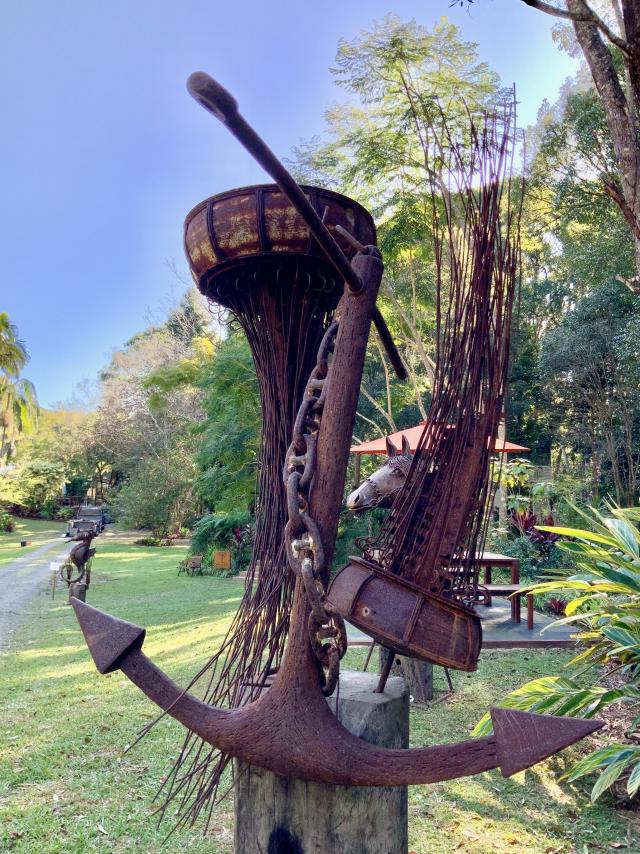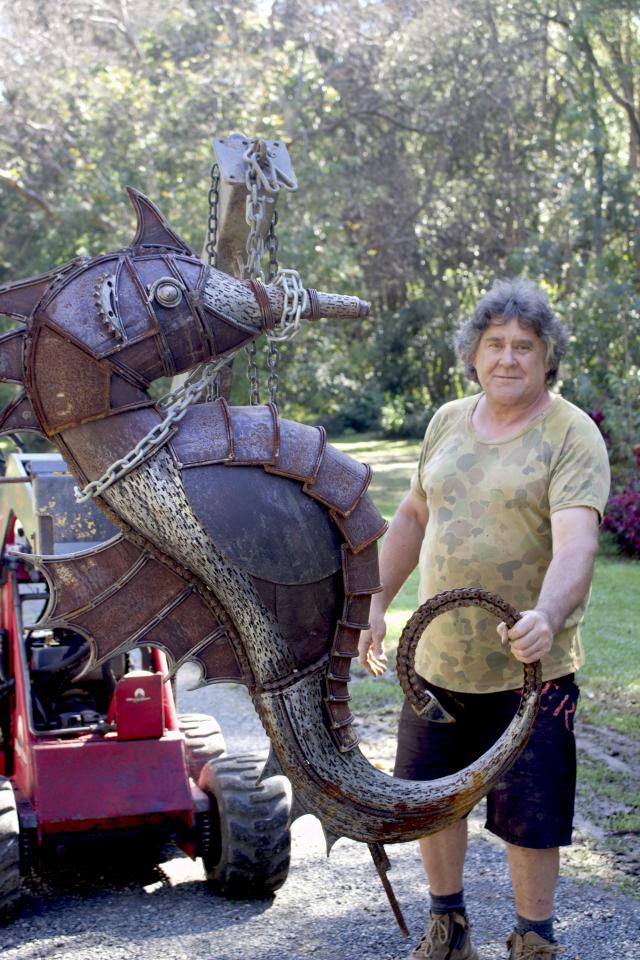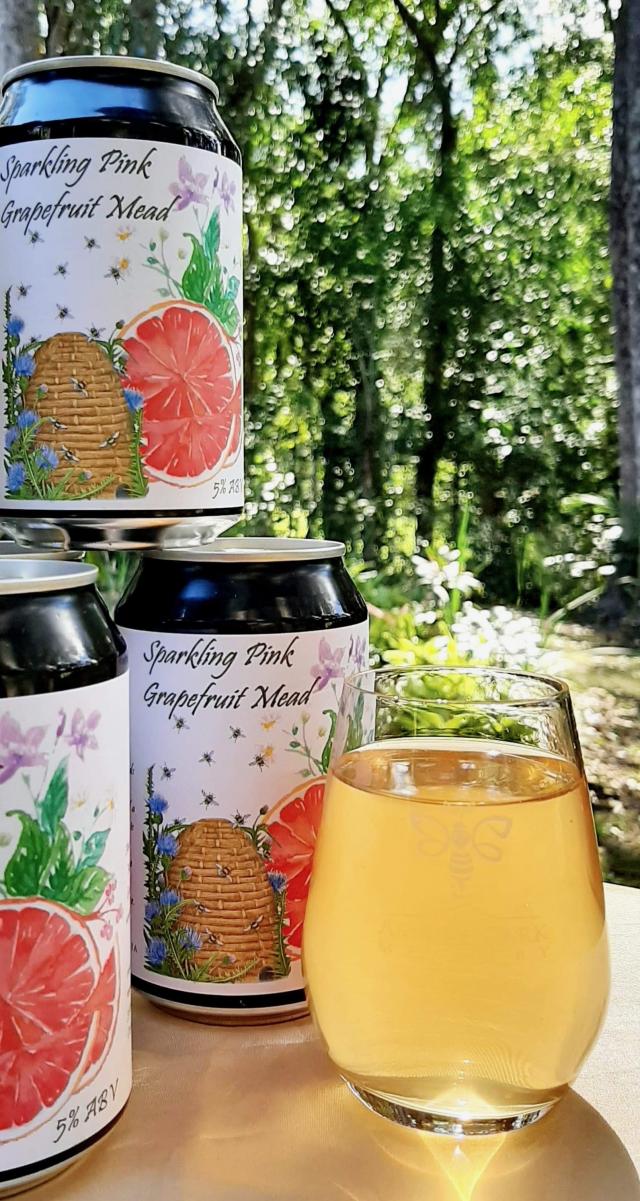Erle Levey
Something mystical is brewing in the shadow of Mt Pinbarren.
Noted Pomona steel sculpture artist Peter Smith has teamed up with award-winning mead makers Andy Coates and Nicola Cleaver as part of the Noosa Open Studios art trail over the first two weekends of this month.
Driving along the Pomona-Kin Kin Road you cannot help but be taken by the perfect cone-shaped Mt Pinbarren dominating the skyline.
As you get closer the plantation of hoop and kauri pines takes on a mystical presence … like something out of Lord of the Rings.
The plantation is on the site of the original Pinbarren State School and later became a World War Two memorial forest.
At the foot of the mountain, and in a leafy environment, you become immersed in the grounds of Amrita Park Meadery.
It’s home to Andy and Nicola who, for the third year running, have taken out Best Traditional Mead honours at the Royal Brisbane Show.
Providing a dramatic welcome to the meadery are a number of larger-than-life steel sculptures by Peter Smith.
A self-taught welder and landscaper, Peter will be on site at Amrita Park Meadery during Noosa Open Studios Art Trail on October 1-3 and October 8-9.
It will be a coming together of two arts – the ancient art of mead making and the raw industrial art of steel sculpture.
Suddenly I’m thinking about medieval times with knights in armour thumping pewter tankards on oak tables and blacksmiths fashioning swords on their anvil.
It’s not far from the truth – Andy and Nicola have been very successful with their range of meads at medieval festivals as well as food and wine functions.
Apart from having taken out Best Traditional Mead honours at the Royal Brisbane Show, they entered their melomel (fruit mead flavours) in the show, against stiff competition.
The melomels took out first, second and fourth in that category.
All the top meads from all sections were then judged, with Amrita Park’s traditional mead offering coming out tops as grand champion.
Yet it is not just the traditional methods that Andy has inherited from his grandfather Dennis Poppo Coates who had been making first class mead and entering competitions in Europe and Australia since the early 1940s.
In their five years at Pomona, Andy and Nicola have been continually experimenting with new products by utilising local fruit and honey.
The most recent product has been sparkling mead.
“Well, we actually just sold out of it at the Moreton Food and Wine Festival,’’ Andy said.
“It was our launch and now we’ve got micro breweries wanting to buy it.
“We also did a sparkling pink grapefruit mead.
“They are both very light and refreshing drinks – more like a light cider, not super sweet and not super dry.
“The grapefruit had a really nice little bitterness. Everyone at the festival was loving it.
“The grapefruit are from here … some from just on the other side of the Kin Kin Range and some from the property that’s near here.’’
Andy and Nicola also created a ginger and lime mead in cans that was trialled at a Slow Food Noosa function and they sold out as well.
The launch of Amrita Park Meadery has been somewhat of a rollercoaster ride.
Just as the pair were getting established, the Covid pandemic hit and everything came to a stop.
Now, as people are relishing in the ability to get out and about again, they’ve gotten “stupidly busy and demand is outstripping supply’’.
Andy said he had just been making batch, after batch, after batch.
“The godsend for us is that we now use kveik yeast which is a high temperature fermenting yeast – it ferments quite fast and it just goes well with honey.
“It allows us to ferment in summer time – to temperatures that still see fermenting at 40 degrees.
“It’s normally traditionally used in ales, like it’s a beer yeast but doesn’t taste beery.
“It just gives such good results.’’
While mead-making is an age-old craft, it has taken a lot of energy plus word-of-mouth and education for modern generations to discover its flavour.
“That highlights the difference,’’ Andy said.
“At the Abbey Medieval Festival recently there was a crowd of 30,000 people who know what mead is.
“You’re not trying to educate these people – they just want to try it and they love it.
“Then fast forward to the Moreton Bay Food and Wine Festival and our main job was educating.
“The first thing people say is: ’What? Mead? I’ve never heard of it. I don’t know what it is. Oh, that’s just something sweet. That’s just a honey beer.’
“It’s almost a generation of people who don’t know about it.
“So we are very aware that our main job is education.
“While many people are unsure about mead, that is changing … and we have so many people who are now followers and sharing our mead, so it’s growing exponentially.’’
When Covid hit and large numbers of people discovered the benefits of working from home and home gardens, people started to search out the old style crafts such as home brewing.
“At the start of Covid, when lockdowns went on, alcohol consumption went up,’’ Andy said.
“A lot.
“But it was the types and styles of alcohol they chose.
“All the cheapest wine and the cheapest beer sales went up, and all of the boutique stuff just fell off a cliff.
“They were taking in account of the cost I suppose and how long Covid was going to be with us … that uncertainty.
“People just didn’t know what was going to happen and they were stuck at home. They were not really sure, so they bought a lot but it was all as cheap as possible.’’
Then it changed, and changed fairly abruptly.
People started to gain confidence and discovered they were OK financially.
But they still had time and realised it wasn’t the end of the world.
That’s when they started buying the boutique and the higher-end wines, spirits and craft beers.
“That made a pretty big difference,’’ Andy said, “and it’s just been going up since then.
“A big difference has been that pre-Covid and during Covid online sales were quite high, but now online sales are quite low.
“It’s our cellar door that is much busier – everyone wants to get out to shows and festivals …. we’ve never seen anything like it.’’
Even with the success of the products, Andy and Nicola want to concentrate on growing the sparkling mead market.
“We don’t want to be big … doing massive 10,000 litre batches.
“Ideally it sort of follows on with the Slow Food ethics where you are not transporting it a long way.
“We go down to the bottom end of the Sunshine Coast, maybe a little bit further, and have a couple of little outlets there.
“The micro breweries want something that’s a bit different.
“But we don’t want to be everywhere. We want to be able to value-add to anyone that has our product in stock.
“People will seek it out. We want to just really support the local side of things.’’
Keeping it local is what steel sculpture artist Peter Smith does.
While working as a landscaper he started the sculptures as personal therapy.
That was four and a half years ago.
“I love the ocean and all of the creatures associated with it that live together,’’ he said.
“Once I have decided on a subject and studied the most notable features I pretty much have it already created in my mind.
“I think my art provides enjoyment and inspiration for others to be creative.
“I also believe it assists the importance of caring for our wonderful creatures.
“I love making sculptures and the joy it brings me and others. And I love it more when standing in a crowd and watching the reactions of other people.’’
Peter mostly uses recycled metal and timber … old beams from buildings and bridges.
There is so much texture in that and the steel from old plough discs, roofing iron that has been flattened out by the artist driving his Dingo landscaping tractor over it.
He also uses 6mm steel rods, welds them in place and then grinds them down where needed to burnish or give a flattened look.
The broken drive-chain from a Dingo provided the basis for his first work of art – a chandelier.
A friend was an artist and they set the chain out in a circle, then added to it.
From there, Peter started making pieces and selling them.
“What started out as therapy for me became a passion.
“I’ve always been right into art, even as a kid at school. That was on Victoria’s Mornington Peninsula.
“When Caroline and I got married we moved here to Pomona.
“That was about 17 years ago.
“I have been inspired by other artists who have complimented me on my artwork.
“I wasn’t really looking to do anything special, it was just for me.
“Then I started getting invited to do shows and exhibitions.’’
Are the steel and timber materials a flow-on from landscaping?
“No, not really. The broken chain from my Dingo was just there by the shed for a year or so.
“I got the arc welder out and made into a perfect circle and turned it into a chandelier.’’
Peter has been creating one-off pieces for private buyers throughout Queensland as well as interstate.
A big sailfish is at Tewantin, a black cockatoo to the west of Gympie, a fabulous eagle at Cooroy, and a triple-winged dragon that was 3.5m wide.
He uses plough discs as the tops of jellyfish and the flowers are all made out of the mowing fingers or teeth from a grain harvester.
Peter will be on site at Amrita Park Meadery on Saturday and Sunday on both weekends during the Noosa Open Studios event.
He will be discussing techniques and explaining the sculptures in place around the grounds of Amrita Park.
Included is a dragon’s head, a giant seahorse, a nautical piece comprising jellyfish and ocean anchor, a horse’s head and smaller items such as some funky flowers, maybe a dragonfly or butterfly, and bees … after all it is a meadery.





